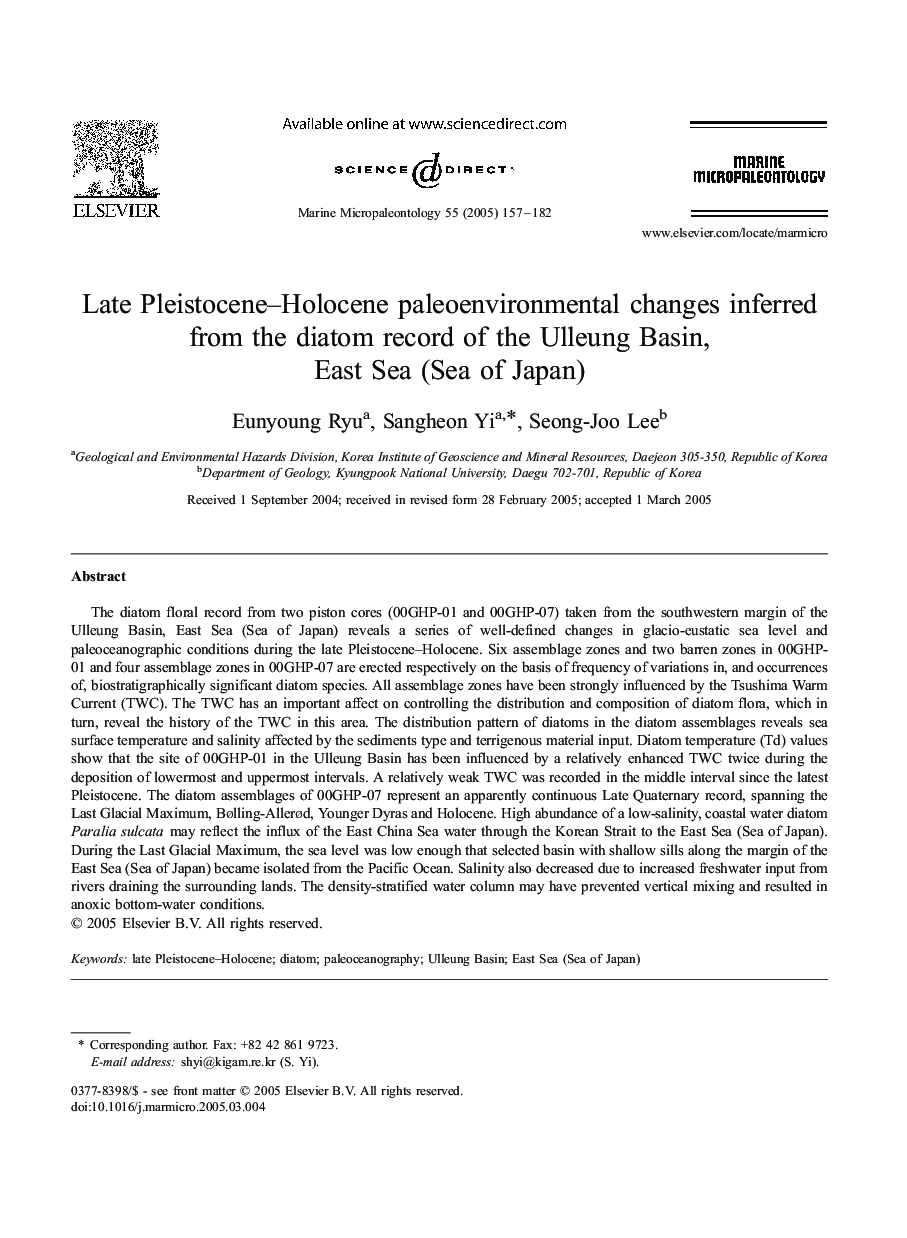| کد مقاله | کد نشریه | سال انتشار | مقاله انگلیسی | نسخه تمام متن |
|---|---|---|---|---|
| 9539704 | 1642238 | 2005 | 26 صفحه PDF | دانلود رایگان |
عنوان انگلیسی مقاله ISI
Late Pleistocene-Holocene paleoenvironmental changes inferred from the diatom record of the Ulleung Basin, East Sea (Sea of Japan)
دانلود مقاله + سفارش ترجمه
دانلود مقاله ISI انگلیسی
رایگان برای ایرانیان
کلمات کلیدی
موضوعات مرتبط
مهندسی و علوم پایه
علوم زمین و سیارات
فسیل شناسی
پیش نمایش صفحه اول مقاله

چکیده انگلیسی
The diatom floral record from two piston cores (00GHP-01 and 00GHP-07) taken from the southwestern margin of the Ulleung Basin, East Sea (Sea of Japan) reveals a series of well-defined changes in glacio-eustatic sea level and paleoceanographic conditions during the late Pleistocene-Holocene. Six assemblage zones and two barren zones in 00GHP-01 and four assemblage zones in 00GHP-07 are erected respectively on the basis of frequency of variations in, and occurrences of, biostratigraphically significant diatom species. All assemblage zones have been strongly influenced by the Tsushima Warm Current (TWC). The TWC has an important affect on controlling the distribution and composition of diatom flora, which in turn, reveal the history of the TWC in this area. The distribution pattern of diatoms in the diatom assemblages reveals sea surface temperature and salinity affected by the sediments type and terrigenous material input. Diatom temperature (Td) values show that the site of 00GHP-01 in the Ulleung Basin has been influenced by a relatively enhanced TWC twice during the deposition of lowermost and uppermost intervals. A relatively weak TWC was recorded in the middle interval since the latest Pleistocene. The diatom assemblages of 00GHP-07 represent an apparently continuous Late Quaternary record, spanning the Last Glacial Maximum, Bølling-Allerød, Younger Dyras and Holocene. High abundance of a low-salinity, coastal water diatom Paralia sulcata may reflect the influx of the East China Sea water through the Korean Strait to the East Sea (Sea of Japan). During the Last Glacial Maximum, the sea level was low enough that selected basin with shallow sills along the margin of the East Sea (Sea of Japan) became isolated from the Pacific Ocean. Salinity also decreased due to increased freshwater input from rivers draining the surrounding lands. The density-stratified water column may have prevented vertical mixing and resulted in anoxic bottom-water conditions.
ناشر
Database: Elsevier - ScienceDirect (ساینس دایرکت)
Journal: Marine Micropaleontology - Volume 55, Issues 3â4, June 2005, Pages 157-182
Journal: Marine Micropaleontology - Volume 55, Issues 3â4, June 2005, Pages 157-182
نویسندگان
Eunyoung Ryu, Sangheon Yi, Seong-Joo Lee,